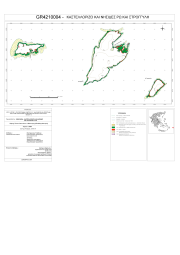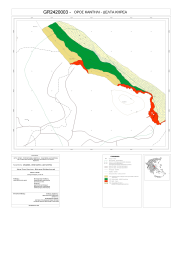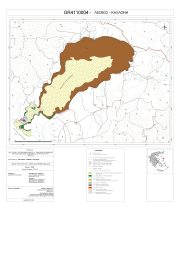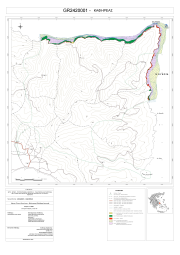Hellenic National Oceanographic Data Centre
Type of resources
Available actions
Topics
Keywords
Contact for the resource
Provided by
Formats
Representation types
Update frequencies
status
Scale 1:
Resolution
-

The description and mapping of marine habitat types according to Annex I of Directive 92/43/EOK (EEC, 1992) and / or the European Nature Information System (EUNIS) in 66 of approximately 300 Greek NATURA 2000 network sites, were the subject of Research Work for the Ministry of Environment Planning and Public Works of Greece. This research project, under the name "Identification and description of habitat types at sites of interest for conservation", lasted from 1999 to 2002 and was carried out by the National Centre for Marine Research (NCMR, renamed as Hellenic Centre for Marine Research - HCMR since 2003) in association with the Institute of Marine Biology of Crete (IBCM, joined to HCMR since 2003), the Aristotle University of Thessaloniki and the Fisheries Research Institute (FRI). The recognition and imprinting of marine habitat types was based on the combined use of aerial photos of scale 1:5000 acquired during the second half of 1999 for the needs of the project, data from the scientific echo sounder Sea-Bed discrimination system "RoxAnn", phytobenthos samples and in situ observations by scuba diving and underwater cameras. Regarding the sampling, hard bottom samplings were carried out using SCUBA diving. The samples were collected on hard substrates mainly in the upper infralittoral zone (30 to 50 cm below the lowest sea level). For the study of the soft bottom habitats, oceanographic cruses were carried out with the IMBC R/V ÔÇ£FiliaÔÇØ, using a Smith McIntyre sediment sampler.
-

The description and mapping of marine habitat types according to Annex I of Directive 92/43/EOK (EEC, 1992) and / or the European Nature Information System (EUNIS) in 66 of approximately 300 Greek NATURA 2000 network sites, were the subject of Research Work for the Ministry of Environment Planning and Public Works of Greece. This research project, under the name "Identification and description of habitat types at sites of interest for conservation", lasted from 1999 to 2002 and was carried out by the National Centre for Marine Research (NCMR, renamed as Hellenic Centre for Marine Research - HCMR since 2003) in association with the Institute of Marine Biology of Crete (IBCM, joined to HCMR since 2003), the Aristotle University of Thessaloniki and the Fisheries Research Institute (FRI). The recognition and imprinting of marine habitat types was based on the combined use of aerial photos of scale 1:5000 acquired during the second half of 1999 for the needs of the project, data from the scientific echo sounder Sea-Bed discrimination system "RoxAnn", phytobenthos samples and in situ observations by scuba diving and underwater cameras. Regarding the sampling, hard bottom samplings were carried out using SCUBA diving. The samples were collected on hard substrates mainly in the upper infralittoral zone (30 to 50 cm below the lowest sea level). For the study of the soft bottom habitats, oceanographic cruses were carried out with the IMBC R/V ÔÇ£FiliaÔÇØ, using a Smith McIntyre sediment sampler.
-

The description and mapping of marine habitat types according to Annex I of Directive 92/43/EOK (EEC, 1992) and / or the European Nature Information System (EUNIS) in 66 of approximately 300 Greek NATURA 2000 network sites, were the subject of Research Work for the Ministry of Environment Planning and Public Works of Greece. This research project, under the name "Identification and description of habitat types at sites of interest for conservation", lasted from 1999 to 2002 and was carried out by the National Centre for Marine Research (NCMR, renamed as Hellenic Centre for Marine Research - HCMR since 2003) in association with the Institute of Marine Biology of Crete (IBCM, joined to HCMR since 2003), the Aristotle University of Thessaloniki and the Fisheries Research Institute (FRI). The recognition and imprinting of marine habitat types was based on the combined use of aerial photos of scale 1:5000 acquired during the second half of 1999 for the needs of the project, data from the scientific echo sounder Sea-Bed discrimination system "RoxAnn", phytobenthos samples and in situ observations by scuba diving and underwater cameras. Regarding the sampling, hard bottom samplings were carried out using SCUBA diving. The samples were collected on hard substrates mainly in the upper infralittoral zone (30 to 50 cm below the lowest sea level). For the study of the soft bottom habitats, oceanographic cruses were carried out with the IMBC R/V ÔÇ£FiliaÔÇØ, using a Smith McIntyre sediment sampler.
-

The description and mapping of marine habitat types according to Annex I of Directive 92/43/EOK (EEC, 1992) and / or the European Nature Information System (EUNIS) in 66 of approximately 300 Greek NATURA 2000 network sites, were the subject of Research Work for the Ministry of Environment Planning and Public Works of Greece. This research project, under the name "Identification and description of habitat types at sites of interest for conservation", lasted from 1999 to 2002 and was carried out by the National Centre for Marine Research (NCMR, renamed as Hellenic Centre for Marine Research - HCMR since 2003) in association with the Institute of Marine Biology of Crete (IBCM, joined to HCMR since 2003), the Aristotle University of Thessaloniki and the Fisheries Research Institute (FRI). The recognition and imprinting of marine habitat types was based on the combined use of aerial photos of scale 1:5000 acquired during the second half of 1999 for the needs of the project, data from the scientific echo sounder Sea-Bed discrimination system "RoxAnn", phytobenthos samples and in situ observations by scuba diving and underwater cameras. Regarding the sampling, hard bottom samplings were carried out using SCUBA diving. The samples were collected on hard substrates mainly in the upper infralittoral zone (30 to 50 cm below the lowest sea level). For the study of the soft bottom habitats, oceanographic cruses were carried out with the IMBC R/V ÔÇ£FiliaÔÇØ, using a Smith McIntyre sediment sampler.
-

The description and mapping of marine habitat types according to Annex I of Directive 92/43/EOK (EEC, 1992) and / or the European Nature Information System (EUNIS) in 66 of approximately 300 Greek NATURA 2000 network sites, were the subject of Research Work for the Ministry of Environment Planning and Public Works of Greece. This research project, under the name "Identification and description of habitat types at sites of interest for conservation", lasted from 1999 to 2002 and was carried out by the National Centre for Marine Research (NCMR, renamed as Hellenic Centre for Marine Research - HCMR since 2003) in association with the Institute of Marine Biology of Crete (IBCM, joined to HCMR since 2003), the Aristotle University of Thessaloniki and the Fisheries Research Institute (FRI). The recognition and imprinting of marine habitat types was based on the combined use of aerial photos of scale 1:5000 acquired during the second half of 1999 for the needs of the project, data from the scientific echo sounder Sea-Bed discrimination system "RoxAnn", phytobenthos samples and in situ observations by scuba diving and underwater cameras. Regarding the sampling, hard bottom samplings were carried out using SCUBA diving. The samples were collected on hard substrates mainly in the upper infralittoral zone (30 to 50 cm below the lowest sea level). For the study of the soft bottom habitats, oceanographic cruses were carried out with the IMBC R/V ÔÇ£FiliaÔÇØ, using a Smith McIntyre sediment sampler.
-

The description and mapping of marine habitat types according to Annex I of Directive 92/43/EOK (EEC, 1992) and / or the European Nature Information System (EUNIS) in 66 of approximately 300 Greek NATURA 2000 network sites, were the subject of Research Work for the Ministry of Environment Planning and Public Works of Greece. This research project, under the name "Identification and description of habitat types at sites of interest for conservation", lasted from 1999 to 2002 and was carried out by the National Centre for Marine Research (NCMR, renamed as Hellenic Centre for Marine Research - HCMR since 2003) in association with the Institute of Marine Biology of Crete (IBCM, joined to HCMR since 2003), the Aristotle University of Thessaloniki and the Fisheries Research Institute (FRI). The recognition and imprinting of marine habitat types was based on the combined use of aerial photos of scale 1:5000 acquired during the second half of 1999 for the needs of the project, data from the scientific echo sounder Sea-Bed discrimination system "RoxAnn", phytobenthos samples and in situ observations by scuba diving and underwater cameras. Regarding the sampling, hard bottom samplings were carried out using SCUBA diving. The samples were collected on hard substrates mainly in the upper infralittoral zone (30 to 50 cm below the lowest sea level). For the study of the soft bottom habitats, oceanographic cruses were carried out with the IMBC R/V ÔÇ£FiliaÔÇØ, using a Smith McIntyre sediment sampler.
-

The description and mapping of marine habitat types according to Annex I of Directive 92/43/EOK (EEC, 1992) and / or the European Nature Information System (EUNIS) in 66 of approximately 300 Greek NATURA 2000 network sites, were the subject of Research Work for the Ministry of Environment Planning and Public Works of Greece. This research project, under the name "Identification and description of habitat types at sites of interest for conservation", lasted from 1999 to 2002 and was carried out by the National Centre for Marine Research (NCMR, renamed as Hellenic Centre for Marine Research - HCMR since 2003) in association with the Institute of Marine Biology of Crete (IBCM, joined to HCMR since 2003), the Aristotle University of Thessaloniki and the Fisheries Research Institute (FRI). The recognition and imprinting of marine habitat types was based on the combined use of aerial photos of scale 1:5000 acquired during the second half of 1999 for the needs of the project, data from the scientific echo sounder Sea-Bed discrimination system "RoxAnn", phytobenthos samples and in situ observations by scuba diving and underwater cameras. Regarding the sampling, hard bottom samplings were carried out using SCUBA diving. The samples were collected on hard substrates mainly in the upper infralittoral zone (30 to 50 cm below the lowest sea level). For the study of the soft bottom habitats, oceanographic cruses were carried out with the IMBC R/V ÔÇ£FiliaÔÇØ, using a Smith McIntyre sediment sampler.
-

The description and mapping of marine habitat types according to Annex I of Directive 92/43/EOK (EEC, 1992) and / or the European Nature Information System (EUNIS) in 66 of approximately 300 Greek NATURA 2000 network sites, were the subject of Research Work for the Ministry of Environment Planning and Public Works of Greece. This research project, under the name "Identification and description of habitat types at sites of interest for conservation", lasted from 1999 to 2002 and was carried out by the National Centre for Marine Research (NCMR, renamed as Hellenic Centre for Marine Research - HCMR since 2003) in association with the Institute of Marine Biology of Crete (IBCM, joined to HCMR since 2003), the Aristotle University of Thessaloniki and the Fisheries Research Institute (FRI). The recognition and imprinting of marine habitat types was based on the combined use of aerial photos of scale 1:5000 acquired during the second half of 1999 for the needs of the project, data from the scientific echo sounder Sea-Bed discrimination system "RoxAnn", phytobenthos samples and in situ observations by scuba diving and underwater cameras. Regarding the sampling, hard bottom samplings were carried out using SCUBA diving. The samples were collected on hard substrates mainly in the upper infralittoral zone (30 to 50 cm below the lowest sea level). For the study of the soft bottom habitats, oceanographic cruses were carried out with the IMBC R/V ÔÇ£FiliaÔÇØ, using a Smith McIntyre sediment sampler.
-

The description and mapping of marine habitat types according to Annex I of Directive 92/43/EOK (EEC, 1992) and / or the European Nature Information System (EUNIS) in 66 of approximately 300 Greek NATURA 2000 network sites, were the subject of Research Work for the Ministry of Environment Planning and Public Works of Greece. This research project, under the name "Identification and description of habitat types at sites of interest for conservation", lasted from 1999 to 2002 and was carried out by the National Centre for Marine Research (NCMR, renamed as Hellenic Centre for Marine Research - HCMR since 2003) in association with the Institute of Marine Biology of Crete (IBCM, joined to HCMR since 2003), the Aristotle University of Thessaloniki and the Fisheries Research Institute (FRI). The recognition and imprinting of marine habitat types was based on the combined use of aerial photos of scale 1:5000 acquired during the second half of 1999 for the needs of the project, data from the scientific echo sounder Sea-Bed discrimination system "RoxAnn", phytobenthos samples and in situ observations by scuba diving and underwater cameras. Regarding the sampling, hard bottom samplings were carried out using SCUBA diving. The samples were collected on hard substrates mainly in the upper infralittoral zone (30 to 50 cm below the lowest sea level). For the study of the soft bottom habitats, oceanographic cruses were carried out with the IMBC R/V ÔÇ£FiliaÔÇØ, using a Smith McIntyre sediment sampler.
-

The description and mapping of marine habitat types according to Annex I of Directive 92/43/EOK (EEC, 1992) and / or the European Nature Information System (EUNIS) in 66 of approximately 300 Greek NATURA 2000 network sites, were the subject of Research Work for the Ministry of Environment Planning and Public Works of Greece. This research project, under the name "Identification and description of habitat types at sites of interest for conservation", lasted from 1999 to 2002 and was carried out by the National Centre for Marine Research (NCMR, renamed as Hellenic Centre for Marine Research - HCMR since 2003) in association with the Institute of Marine Biology of Crete (IBCM, joined to HCMR since 2003), the Aristotle University of Thessaloniki and the Fisheries Research Institute (FRI). The recognition and imprinting of marine habitat types was based on the combined use of aerial photos of scale 1:5000 acquired during the second half of 1999 for the needs of the project, data from the scientific echo sounder Sea-Bed discrimination system "RoxAnn", phytobenthos samples and in situ observations by scuba diving and underwater cameras. Regarding the sampling, hard bottom samplings were carried out using SCUBA diving. The samples were collected on hard substrates mainly in the upper infralittoral zone (30 to 50 cm below the lowest sea level). For the study of the soft bottom habitats, oceanographic cruses were carried out with the IMBC R/V ÔÇ£FiliaÔÇØ, using a Smith McIntyre sediment sampler.
 EMODnet Product Catalogue
EMODnet Product Catalogue